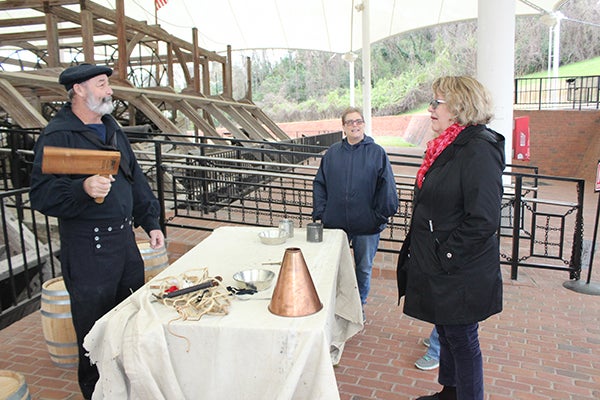Re-enactors give visitors an idea of life on USS Cairo
Published 8:08 pm Tuesday, December 18, 2018

- Re-enactor Curtis Gordon, left, demonstrates an alarm used on gunboats as Mary Whitney, center, and Donna Byrd look on. Whitney and Byrd were visiting the USS Cairo and its museum and stopped to look at the display of items used on the gunships. (John Surratt/The Vicksburg Post)
The visitor pointed to a strange looking L-shaped item sitting on a table in front of the USS Cairo.
“That is an alarm,” said Curtis Gordon, a re-enactor dressed as a Union sailor. He picked it up and spun the ratchet-sounding device around several times. “If there was an emergency, someone would grab that and turn it to get attention. There were so many different sounds going on in the boat.”
Gordon was one of several re-enactors dressed in the blue uniforms of enlisted sailors at the Vicksburg National Military Park’s Cairo exhibit and museum Saturday talking about the brown water Navy, the term for the Union’s gunboats that patrolled the Mississippi River and it tributaries.
“We’re doing demonstrations — living history — basically talking to visitors and describing life on board the gunboats,” said ranger Lela White, the park’s living history coordinator.
“We have demonstrations of sewing and knot tying, people are allowed to tie knots and learn about the different knots they were using, and they can talk to our sailors about what life was like on the gunboats.”
And that life was difficult.
A miserable life
Gordon described life on an ironclad gunboat as “very hot, stifling, loud.”
The boat’s engines, he said, were open, and the boilers were operating at 800, 900 or 1,000 degrees. making the onboard temperature in the boat in excess of 100 degrees, “Plus, it would be very steamy.”
There wasn’t a lot of fresh water, making bathing difficult, he said, “So you did your best with a comb and occasional ventures out into the water, which was seldom (because of Confederate snipers on the shore). The only time you could was in a secure area, and even then, if you were in hostile waters, you had to stay below decks, which put you in a hot environment.
“If there were no enemy troops about, you could at least go on deck and get some relief from the heat.”
All the work on the boat involved manual labor, and most of a sailor’s time was spent cleaning the boat, he said, adding cleaning the boats and keeping it “shipshape” — a practice that continues in the modern Navy.
The sailors also had to maintain their uniforms, and those sailors who had extra personal time and good with needle and thread embellished their uniforms with decoration, Gordon said, adding the boat’s museum held several examples of ornate uniforms.
In the winter, he said a boat’s interior would have been damp because of the escaping steam condensing on the walls.
“Anything level, there would have been loads of water,” he said.
And opportunities to leave the boats were few.
“Most times, even when they put into port, they would be confined to the boat, because most of the sailors were volunteers, and the tendency was if they got into shore, they would try to desert, because they (boat conditions) were appalling conditions,” Gordon said. “That was both in the brown water Navy and the blue water Navy.”
Gordon said he has been a park volunteer for 30 years, beginning as a member of a gun crew in the late 1980s. “I’ve done infantry, artillery and now sailor impressions. I’ve always enjoyed it.”





